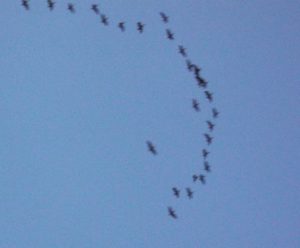
This tall plant, towering over everything else, is elecampane growing in a herb garden somewhere along the Clyde. I do have some in my garden and it is indeed as wild and rampageous as this, at least two metres tall, and flowering madly through the late summer. When I first got to know this garden I was convinced it wanted me to plant elecampane, and because I thought I had enough space for it, I was glad to do it. It’s bright and cheerful, it has an ancient traditional place in herbal medicine, and it grows wild around here, in neglected spaces. It thrives here, to the point where I’ve had to thin it out already.
Culpeper claims that this plant is under the dominion of Mercury, which is reponsible for herbs governing the mind, nerves, respiration and communication. This has been a promising wormhole to explore. I had thought that the astrology of herbs was a useful classification system before Linnaeus, and to some extent this is the case – complaints and areas of the body are atrributed to the various planets, and relevant herbs are assigned to them. There are common characteristics, too – moon herbs are often sappy, gentle and water-loving, whereas sun herbs are upright, warming and mostly have golden flowers. Saturn owns a lot of cold soporific and poisonous herbs, and Mars has stimulating ones with harsh tastes, and prickles and thorns. Mars has a lot of wound herbs and Venus helps with gynaecological issues. I know herbalists who can assign a herb to its planet and function by the taste or look of it and some categorisation must have helped.
The interesting thing I found when I compiled my list, was how many of the plants which do unexpectedly well in this garden are under Mercury – lavender, santolina, southernwood, lily of the valley. The soil here is less acid than in my previous garden, and the climate is gentler, so I expected some difference, but I never looked at planets. Moon herbs and the herbs of Venus are doing well, and the sun herbs are not too bad, but herbs belonging to Saturn and Jupiter are struggling. I am not convinced that actual planetary influences are at work here, but when our ancestors drew up these categories, they weren’t working simply with superstition and magic. There are characteristics in common that I just don’t know enough to spot. I am looking forward to finding out more about soil, aspect, drainage and plant associations as the growing season goes on, and particularly what it was about the garden that convinced me elecampane was the right plant.

We have just reached this point in the garden, where the daffodils are out, the tulips are thinking about it, and the primroses and violets are blooming and colonising new space. The first trees are at bud burst and there’s an exciting green haze on the hedges. Most of the perennials are now showing new growth, and the greenhouse is full of hopeful seed trays. I’ve heard the first bees on sunny afternoons. There is an enormous magpie’s nest in one of the trees behind the house, and whole squadrons of them terrorise the other birds, lining up like storm troopers in an ambush on the roof-tops and shouting at everything that comes too close. There is a robin’s nest in the hawthorns growing over the burn, and the trees lining the footpath are full of sparrows and bluetits, blackbirds, wren and chaffinches. The ground is very wet and all the burns are running high, but the soil is not so saturated that anything has come to harm.
I have made a new propagation area beside the greenhouse where the noonday sun will hit it, and I reckon I will have a lot of plants to share. (If you’re in Glasgow and would like some, please ask!) I took cuttings and saved seedlings as insurance against the cold and damp of winter, but I lost very few plants apart from purple sage, and when this year’s seeds come through I won’t know where to put everything. I’m going to have a nine herbs bed beside the apple tree (the nettle is going to be hidden behind the shed) and a scented garden below the damson. Culinary herbs will be closer to the house, and flowers for cutting and drying and pollinators will be in the front, where they will make a change from the conventional grass and bedding. Someone asked me if my garden was full of weeds, and frankly, yes it is – but also bees and butterflies. Mercury is a very unconventional planet – I’m not surprised this garden is too.




